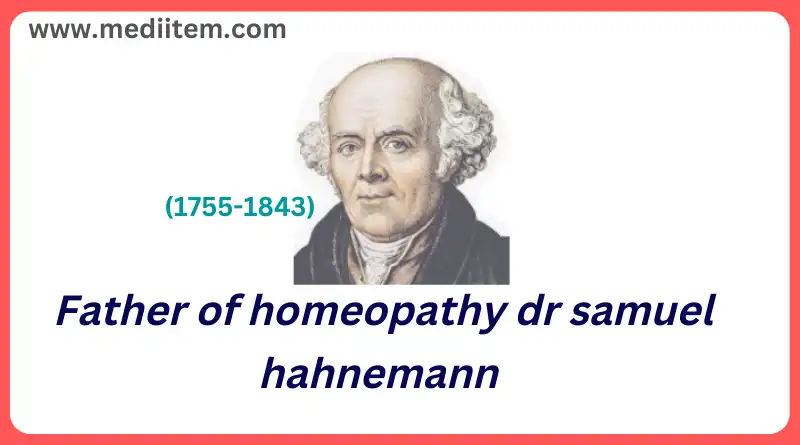Father of homeopathy dr samuel hahnemann
Father of homeopathy dr samuel hahnemann born in Dressen, a small town in northern Saxony, Germany, in 1755. As a child, Hahnemann studied Latin, Greek, Hebrew, history, physics, botany, and medical sciences, under the supervision of teachers who recognized his academic gifts.
He received a good education and studied chemistry and medicine at the universities of Leipzig, Erlangen, and Vienna. After earning his medical degree in 1779, he set up a practice. Hahnemann worked as a doctor and also wrote articles and books on medicine.
In these texts, he protested against the aberrant medical practices of his time, especially against bloodletting, purging, and drastic doses of drugs that harmed and intoxicated patients, with dire side effects. Hahnemann became increasingly disappointed by this and so left the medical profession to work as a translator.
In 1790, while translating Dr. William Cullen’s Treatise on Materia Medica, Hahnemann read a passage about cinchona, or cinchona, that caught his attention. In his book, Cullen claimed that Quina or Cinchona was an excellent treatment for malaria due to its astringent properties. Hahnemann thought this made no sense since, as a chemist, he was aware that there were other much more powerful astringents that had absolutely no effect on malaria. He decided to investigate further.
For several days he took drachmas of good cinchona and took detailed notes of everything that happened in his body. To his surprise, he presented the symptoms of malaria one by one, even though he did not have the disease.
The symptoms recurred each time he took a dose of quinine and lasted for several hours. If he didn’t ingest it, he had no symptoms. He wondered if that was the reason why malaria was also cured with quinine. To test his theory, he repeated the quinine doses-what he called tests people he knew well, and re-recorded the reactions in detail. He then repeated the process using other substances that were used as medicines, such as arsenic and belladonna.
The tests were carried out under strict conditions, and those undergoing the tests were not allowed to eat or drink anything that could confound the results, such as alcohol, tea, coffee, and salty or spicy foods. Father of homeopathy dr Samuel Hahnemann is considered the father of homeopathy, although it was his son Frederick who promoted the development of homeopathic practices.
Today, most clinicians categorically reject the system as unscientific. Despite this, there are homeopathic doctors who enjoy a certain prestige (especially in Germany and France) and homeopathic remedies are accepted as a therapeutic possibility alongside traditional medicines and plants.
Birth Father of homeopathy dr samuel hahnemann
Father of homeopathy dr samuel hahnemann (1755-1843) found that the responses of these people varied; some showed some mild symptoms in response to the substance, while others experienced strong reactions with a variety of symptoms. He called first-line symptoms or key symptoms those that appeared most frequently with each substance.
Second-line symptoms were less common, and third-line symptoms were infrequent or idiosyncratic. The combination of symptoms formed a ‘medicine chart’ for each substance tested. Hahnemann continued to carry out his experiments and tests and analyzed a wide range of natural sources.
He had rediscovered the principle that ‘like can cure like’, “similia similibus curantur” and from his investigations would derive the establishment of a new medicine: homeopathy. This experience convinced Hahnemann that small doses of the same substance would prompt the body’s own immune system to fight off disease (in the same way that a flu shot that carries deactivated germs prevents the flu).
This led to his theory that “likes are cured by likes” that is, diseases can be cured with those drugs that produce disease-like symptoms in healthy people. These ideas were the subject of controversies and enmities on the part of traditional doctors and apothecaries (the latter for preparing Hahnemann’s remedies) which forced him to emigrate, first to Denmark and then to France, spending the last years of his life in Paris. of the. His ideas are collected in his “Organon del Arte de Curar” in its six editions, the last of which was published in 1920.
similia similibus curantur
Hahnemann was not the first to come up with the idea that “likes are cured by likes.” Philosophers and physicians have advanced the idea on and off for thousands of years. The philosophical basis for this idea has been attributed to the Greek Empedocles (ca. 490-430 BC) and Hippocrates (ca. 460-377 BC). This phenomenon is also mentioned in ancient Indian and Chinese medical texts.
More information
Read more: What is the best prescription medicine for hemorrhoids
Read more: Homeopathic Nuphar Luteum for erectile dysfunction
Read more: Homeopathy chelidonium q for fatty liver jaundice
Read more: Bryonia alba 200 homeopathic medicine uses
Read more: Homeopathic pain killer medicine name
Read more: Best homeopathic medicine for negative thinking
Read more: What is the best prescription medicine for hemorrhoids
Read more: How to reduce blood sugar level immediately
Read more: Homeopathy medicine for acidity
Read more: Homeopathic medicine for sexually long time
Please subscribe to my channel and follow
YouTube



